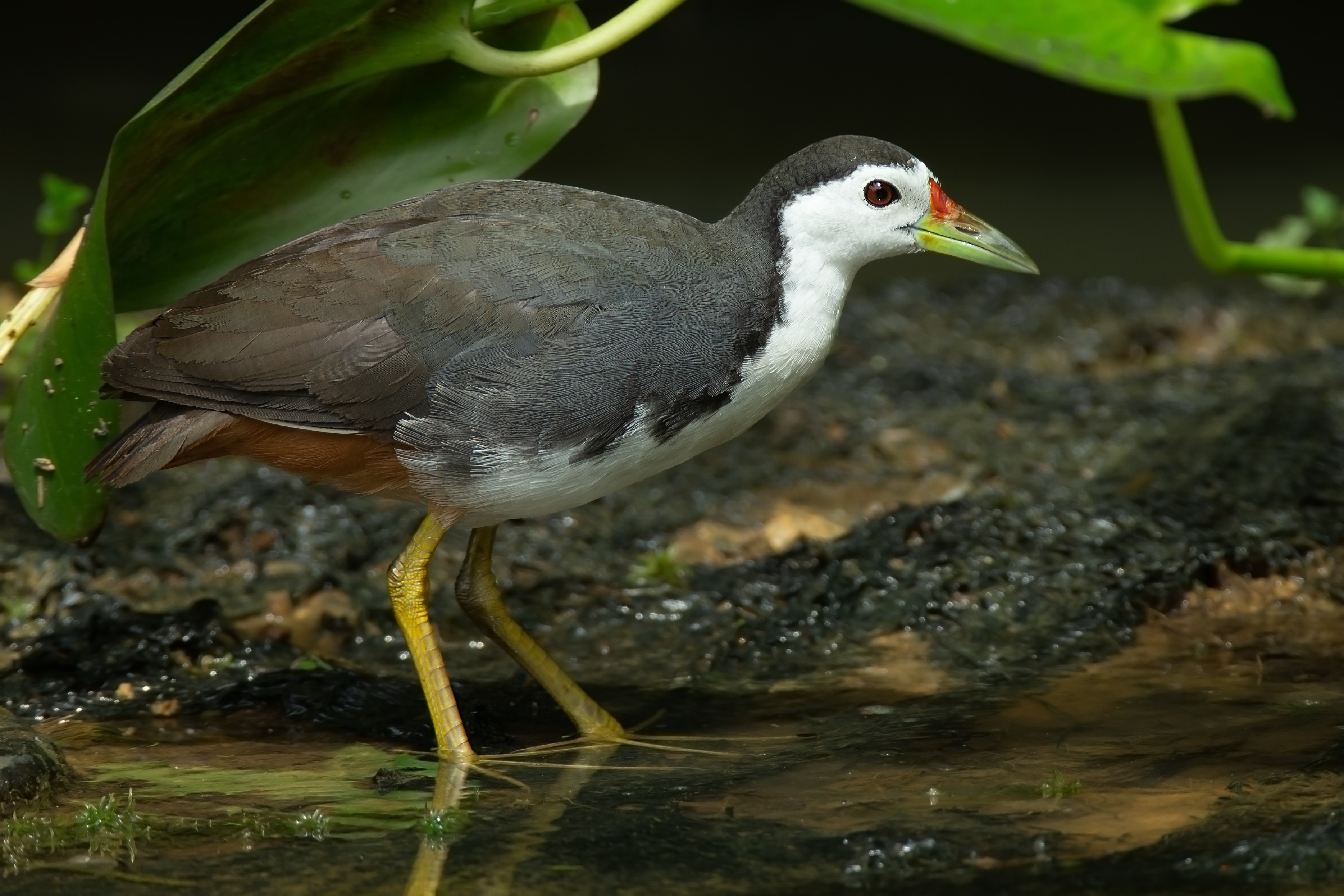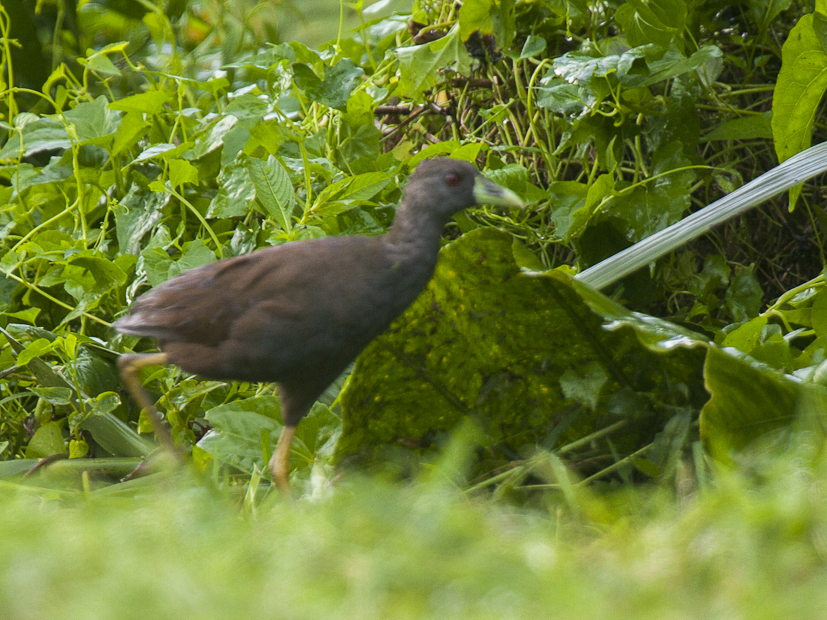|
Amaurornis
''Amaurornis'' is a genus of birds in the rail family Rallidae. The species in this genus are typically called bush-hens. A monotypic subtribe, Amaurornithina, was proposed for this genus. Taxonomy The genus ''Amaurornis'' was erected by the German naturalist Ludwig Reichenbach in 1853 with the plain bush-hen (''Amaurornis olivacea'') as the type species. The name comes from the Greek ''amauros'', meaning "dusky" or "brown" and ''ornis'', meaning "bird". The New Guinea flightless rail was sometimes included in this genus, but more often held to constitute a distinct monotypic genus ''Megacrex''. The first cladistic studies of rails, based on morphology (biology), morphology, strongly suggested that ''Amaurornis'' as traditionally defined is not monophyletic, and that several species placed here are in fact closer to the small crakes traditionally placed in ''Porzana''. This was subsequently confirmed by molecular data. However, these smallish species are probably not close to t ... [...More Info...] [...Related Items...] OR: [Wikipedia] [Google] [Baidu] |
White-breasted Waterhen
The white-breasted waterhen (''Amaurornis phoenicurus'') is a waterbird of the rail and crake family, Rallidae, that is widely distributed across South and Southeast Asia. They are dark slaty birds with a clean white face, breast and belly. They are somewhat bolder than most other rails and are often seen stepping slowly with their tail cocked upright in open marshes or even drains near busy roads. They are largely crepuscular in activity and during the breeding season, just after the first rains, make loud and repetitive croaking calls. Description Adult white-breasted waterhens have mainly dark grey upperparts and flanks, and a white face, neck and breast. The lower belly and undertail are cinnamon or white coloured. The body is flattened laterally to allow easier passage through the reeds or undergrowth. They have long toes, a short tail and a yellow bill and legs. Sexes are similar but females measure slightly smaller. Immature birds are much duller versions of the adults. ... [...More Info...] [...Related Items...] OR: [Wikipedia] [Google] [Baidu] |
Amaurornis
''Amaurornis'' is a genus of birds in the rail family Rallidae. The species in this genus are typically called bush-hens. A monotypic subtribe, Amaurornithina, was proposed for this genus. Taxonomy The genus ''Amaurornis'' was erected by the German naturalist Ludwig Reichenbach in 1853 with the plain bush-hen (''Amaurornis olivacea'') as the type species. The name comes from the Greek ''amauros'', meaning "dusky" or "brown" and ''ornis'', meaning "bird". The New Guinea flightless rail was sometimes included in this genus, but more often held to constitute a distinct monotypic genus ''Megacrex''. The first cladistic studies of rails, based on morphology (biology), morphology, strongly suggested that ''Amaurornis'' as traditionally defined is not monophyletic, and that several species placed here are in fact closer to the small crakes traditionally placed in ''Porzana''. This was subsequently confirmed by molecular data. However, these smallish species are probably not close to t ... [...More Info...] [...Related Items...] OR: [Wikipedia] [Google] [Baidu] |
Pale-vented Bush-hen
The pale-vented bush-hen or rufous-tailed bush-hen (''Amaurornis moluccana'') is a medium sized waterbird, mainly blue-grey with a buff vent and undertail. It is found in Australia, the Moluccan Islands, New Guinea, the Bismarck Archipelago and the Solomon Islands. Its natural habitat is subtropical or tropical moist lowland forests. Taxonomy and systematics The pale-vented bush-hen is a member of the ''Rallidae'' family which includes crakes and rails. The genus name ''Amaurornis ('' Reichenbach 1853'')'' is from the Greek for dark, shadowy or dim, ''amauros,'' and bird, ''ornis.'' The species name ''Amaurornis moluccana'' ''('' Wallace, 1865) means "Moluccan dark and shadowy bird" and relates its original discovery in the Moluccan Islands, Indonesia. The term pale-vented came into use in the late 1990s as a descriptive term, when the species of bush hens in Australia and New Guinea were separated from the Plain Bush-hen (''A. olivaceus'') endemic to the Philippines. It is ... [...More Info...] [...Related Items...] OR: [Wikipedia] [Google] [Baidu] |
Plain Bush-hen
The plain bush-hen (''Amaurornis olivacea''), also named Philippine bush-hen or simply bush-hen , is a species of bird in the family Rallidae. It is endemic to the Philippines. Description and taxonomy EBird describes the bird as "A large ground bird of grass, scrub, and forest edge, usually close to water. Slate-gray on the head and underparts, blending to a brown back and tail. Note the greenish-yellow bill and the long yellow legs. Similar to Tabon Scrubfowl, but usually found near water and outside of forest, and distinguished by yellow legs, thicker bill, and lack of bare facial skin. Highly vocal and much more often heard than seen. Voice includes a rhythmic quacking and harsh rasps." It was formerly conspecific with the Pale-vented bush-hen but is differentiated by its much darker plummage. This species is monotypic Ecology and behavior There have been no species specific studies on its breeding and diet but it is pressumed to have the same behaviour as the ... [...More Info...] [...Related Items...] OR: [Wikipedia] [Google] [Baidu] |
Isabelline Bush-hen
The isabelline bush-hen (''Amaurornis isabellina''), also known as Sulawesi waterhen or isabelline waterhen, is a large, up to 40 cm long, rufous and brown rail. The term '' isabelline'' refers to the colouration. It is the largest member of the genus ''Amaurornis''. Both sexes are similar with olive brown plumage, pale green bill, greenish brown legs and rufous below. An Indonesian endemic, the isabelline waterhen is confined to grasslands near waters and lowlands of Sulawesi. The call is a loud "tak-tak-tak-tak". Widespread throughout its natural habitat, the isabelline waterhen is evaluated as least concern on the IUCN Red List The International Union for Conservation of Nature (IUCN) Red List of Threatened Species, also known as the IUCN Red List or Red Data Book, founded in 1964, is an inventory of the global conservation status and extinction risk of biological ... of Threatened Species. References External links BirdLife Species Factsheet Amauro ... [...More Info...] [...Related Items...] OR: [Wikipedia] [Google] [Baidu] |
Amaurornis Isabellinus(1)
The isabelline bush-hen (''Amaurornis isabellina''), also known as Sulawesi waterhen or isabelline waterhen, is a large, up to 40 cm long, rufous and brown rail. The term '' isabelline'' refers to the colouration. It is the largest member of the genus ''Amaurornis''. Both sexes are similar with olive brown plumage, pale green bill, greenish brown legs and rufous below. An Indonesian endemic, the isabelline waterhen is confined to grasslands near waters and lowlands of Sulawesi. The call is a loud "tak-tak-tak-tak". Widespread throughout its natural habitat, the isabelline waterhen is evaluated as least concern on the IUCN Red List The International Union for Conservation of Nature (IUCN) Red List of Threatened Species, also known as the IUCN Red List or Red Data Book, founded in 1964, is an inventory of the global conservation status and extinction risk of biological ... of Threatened Species. References External links BirdLife Species Factsheet Amaurorn ... [...More Info...] [...Related Items...] OR: [Wikipedia] [Google] [Baidu] |
Talaud Bush-hen
The Talaud bush-hen (''Amaurornis magnirostris'') is a vulnerable waterbird in the rail and crake family. It is a recently described species from Karakelang Island in the Talaud Islands, Indonesia. It occurs in forest, scrub, and overgrown plantations. Description Talaud bush-hen is a 30.5 cm long, large, very dark and robust bush-hen. Its large head and its upperparts are dark brown, its underparts and flanks are very dark bluish grey. The large, thick bill is pale green, and the legs are yellow, becoming more olive at the rear. The only confirmed call of this shy species is a series of loud, low-pitched croaking barks, but it is likely that it also makes the shrieks typical of bush-hens. Status The population is estimated at 2,350-9,560 individuals on Karakelang. It may also occur on neighbouring islands, but there is little forest on those, less than 20 km2 compared to 350 km2 on Karakelang. There are two protected areas totalling 21,800 hectares, but th ... [...More Info...] [...Related Items...] OR: [Wikipedia] [Google] [Baidu] |
New Guinea Flightless Rail
The New Guinea flightless rail (''Megacrex inepta''), also known as the Papuan flightless rail, is a species of bird in the family Rallidae, in the monotypic genus ''Megacrex''. Sometimes however, it was included in ''Amaurornis'' or ''Habroptila'', but this is incorrect. Distribution and habitat It is sparsely found across New Guinea. Its natural habitats are subtropical or tropical moist lowland forests, subtropical or tropical mangrove forests, and subtropical or tropical swamps. It is threatened by habitat loss. Systematics and evolution ''M. inepta'' is indeed closely related to ''Amaurornis'', but not as close as to warrant inclusion therein. Rather, it is part of a group including the core group of the polyphyletic ''Amaurornis'', as well as the monotypic genera '' Aenigmatolimnas'' (striped crake), '' Gallicrex'' (Watercock) and '' Himantornis'' (Nkulengu rail). Most of these rails occur in tropical Asia. The Nkulengu rail from the tropical rainforests of Africa is partic ... [...More Info...] [...Related Items...] OR: [Wikipedia] [Google] [Baidu] |
Bush-hen LaceysCk Apr08 , (''Gallirallus australis'') a flightless bird endemic to New Zealand
{{Disambiguation, bird ...
Bush hen is a name used for a number of bird species: * Plain bush-hen (''Amaurornis olivacea'') * Isabelline bush-hen (''Amaurornis isabellina'') * Talaud bush-hen (''Amaurornis magnirostris'') *Weka The weka, also known as the Māori hen or woodhen (''Gallirallus australis'') is a flightless bird species of the rail family. It is endemic to New Zealand. Some authorities consider it as the only extant member of the genus '' Gallirallus''. ... [...More Info...] [...Related Items...] OR: [Wikipedia] [Google] [Baidu] |


